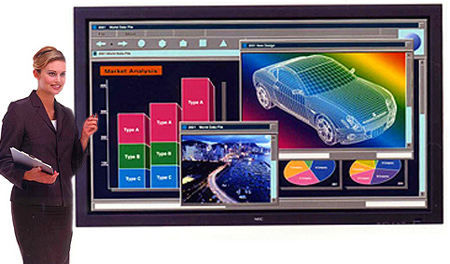Toshiba is hier ook mee bezig, een tijdje terug stond er op tweakers
een stukje van Canons vierjaarlijkse expositie in Parijs. De media totaal schreef na dezelfde expositie over SED dat de ontwikkelingen eigenlijk al een jaar stil stonden en ze plasma en lcd tv's uit het jaar nul nodig hadden om SED er goed uit te laten komen. Hiermee wil ik niet zeggen dat SED geen goed altenatief gaat worden, alleen dat de laatste berichtgevingen over SED niet echt gunstig zijn. Toshiba zou eind 2005 al een scherm leveren, deze is ook nog niet gesignaleerd. Het verhaaltje op fortune lijkt ook meer propaganda dan wetenschap en het eind belooft ook niets goeds: "Mitarai is betting that, five years on, the picture will be just as bright for flat-screen TVs using the SED technology that Canon is developing jointly with Toshiba. Canon engineers, who have been tinkering with the technology since 1986, say it will yield images of dramatically superior quality to liquid-crystal or plasma screens while consuming far less power. A prototype at the headquarters of the Canon--Toshiba joint venture in a quiet suburb 40 miles south of Tokyo seems to live up to the hype: images that are almost palpable, rich colors, and clarity even with rapid movement. It also got a good reception at the Consumer Electronics Show in Las Vegas last month. "Five minutes with this sleek puppy, and plasma and LCD were but a memory," raved a technology writer for the Atlanta Constitution. "Daddy wants one."
The new SED displays operate on the same principle as a cathode-ray television, emitting light by shooting electrons into a phosphor-coated screen. But where cathode-ray TVs use a single large electron gun that has to be set back from the glass screen (meaning they're usually as deep as they are wide), SED screens are illuminated with millions of tiny electron guns known as emitters that can be aimed at point-blank range, enabling images to be projected across wide screens only a few centimeters deep. Canon has invested $1.8 billion developing the technology for the screens and building the factories to produce them. It plans to roll out the first 55-inch screens for consumers in Japan later this year. Mitarai says he wants to offer the TVs for about the same price as LCD and plasma screens of comparable size. He hopes to expand capacity to three million panels a year and capture at least 20% of the global market for flat-screen TVs by 2010. "We have big plans for the digital television business," Mitarai announced at a Canon exhibition late last year. "We intend to grow this area into a new business pillar for Canon."
With SED screens, Mitarai is thinking big in more ways than one. The common TV, he predicts, is destined to morph into something far more useful--what he calls a "multifunction information device," with potential applications in other areas where Canon has patents and expertise. "In the near future," says Mitarai, "SED displays will serve as an image and information window in living rooms, linked through a wireless connection with digital cameras, digital video camcorders, printers, and other imaging devices. Digital photos and video can be stored in electronic albums on a network, and users can view these on an SED display anytime or print them on the spot."
The key question is whether production costs can be lowered far enough and fast enough to turn a profit. Goldman's Horie has his doubts, but he remains bullish on Canon's stock. If the SED falls behind projections, he reasons, Mitarai won't hesitate to close it down."
Een echt ideaal scherm lijkt er de komende jaren nog niet te gaan komen. Plasma brand nog steeds in (gisteren naar een drietal 6e generatie pioneer plasma's staan kijken, na twee minuten het dvdmenu aan zijn de items uit het menu de komende vijf minuten heel licht zichtbaar op lichte vlakken. Alle LCD schermen die er stonden haalden het qua kleuren (vooral zwart) niet bij de plasma's.
 Een 40" lcd-scherm zou, na een prijsdaling van 36% in 2005, eind 2006 opnieuw 25% goedkoper zijn geworden, verwachten analisten. Hoewel ook plasmachermen vorig jaar voor 31% minder over de toonbank gingen, zullen de prijzen voor die apparatuur dit jaar niet méér dalen dan die van de lcd's. Een van de fabrikanten die momenteel beide schermen levert, Samsung, rekent 2800 dollar voor een 40" lcd-tv, terwijl een plasmascherm van 42" 2600 dollar moet opbrengen. De lagere productiekosten van de plasmatechnologie zijn voor diverse fabrikanten niet het belangrijkste argument. Sony's Europese directeur Fujio Nishida stelde simpelweg dat zijn bedrijf zich voornamelijk op lcd zal richten: 'We hebben besloten dat dat de toekomst is.'
Een 40" lcd-scherm zou, na een prijsdaling van 36% in 2005, eind 2006 opnieuw 25% goedkoper zijn geworden, verwachten analisten. Hoewel ook plasmachermen vorig jaar voor 31% minder over de toonbank gingen, zullen de prijzen voor die apparatuur dit jaar niet méér dalen dan die van de lcd's. Een van de fabrikanten die momenteel beide schermen levert, Samsung, rekent 2800 dollar voor een 40" lcd-tv, terwijl een plasmascherm van 42" 2600 dollar moet opbrengen. De lagere productiekosten van de plasmatechnologie zijn voor diverse fabrikanten niet het belangrijkste argument. Sony's Europese directeur Fujio Nishida stelde simpelweg dat zijn bedrijf zich voornamelijk op lcd zal richten: 'We hebben besloten dat dat de toekomst is.'

:strip_exif()/i/1198584344.jpg?f=fpa)